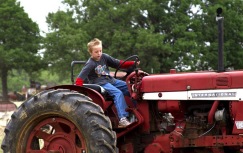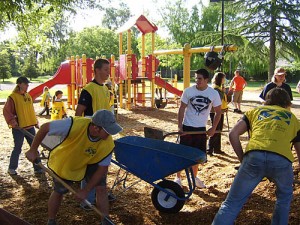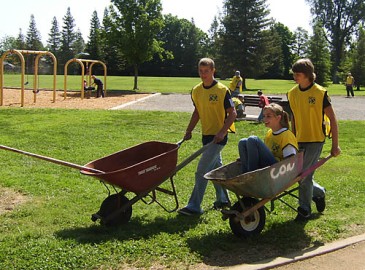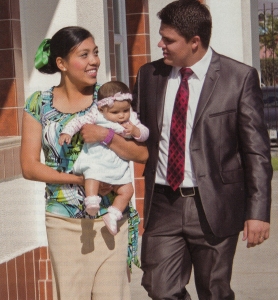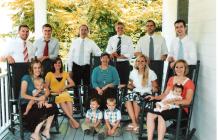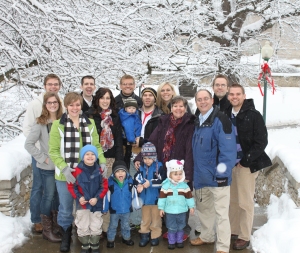One of my sons just became a father. Words cannot describe how happy he and his wife are. His hopes for his son are unbounded. It started me thinking about my relationship with God.
Good:
Over the years, life has taught me that God wants me to come as I am. He wants me to learn to be happy regardless of my circumstances, problems or pains, successes or failures. If I’ve got mud on my face, He’ll take me that way. If it will make me happier, He hands me a washcloth. While He may not care about the mud of dirt, He wants me to avoid face planting in the spiritual mud, and He patiently stands by and welcomes me back each time I’ve hit the mud puddles again. Importantly, He expects the same of others around me, encouraging those with ears to hear to welcome me back as well. As I receive the washcloth over and over, eventually I can teach myself to face plant only when there’s a good reason (like when it’s actual mud of dirt and there are grandkids around who need to be taught by example to love playing in the mud).
 I have learned that God wants me to let go of my past, to let go of the ungodly, unrighteous things I’ve done when I was pushing Him away, when I was singing not His song but rather my own discordant one. He wants me to be comfortable showing up, participating with gusto, practicing over and over, without putting on a false front or prettying myself up first. I can come and sing, mud, sour notes, and all.
I have learned that God wants me to let go of my past, to let go of the ungodly, unrighteous things I’ve done when I was pushing Him away, when I was singing not His song but rather my own discordant one. He wants me to be comfortable showing up, participating with gusto, practicing over and over, without putting on a false front or prettying myself up first. I can come and sing, mud, sour notes, and all.
Better:
 More importantly, I really think that God also wants me to put my best foot forward. When I don my Sunday-go-to-meetin’ clothes, I show respect for God by putting on the best that I have, whatever that is for me.
More importantly, I really think that God also wants me to put my best foot forward. When I don my Sunday-go-to-meetin’ clothes, I show respect for God by putting on the best that I have, whatever that is for me.
Best:
 Most importantly, God wants me to keep on keepin’ on. He doesn’t want me to get stuck.
Most importantly, God wants me to keep on keepin’ on. He doesn’t want me to get stuck.
He doesn’t want any of us to get stuck.
 The enemies of God try to convince me that I can’t improve or shouldn’t improve, that I’m a lost cause, that there’s simply no use in trying, that it’s silly to learn the dance and sillier still to try to hear the music. I’m here to tell you that they’re wrong. Real life begins when I decide to progress, to progress continually, to progress towards Him. God wants me to get off my duff and to get moving in His direction. And according to His principles. He wants me to know that He’s beside me, as I learn to improve, as I learn the joy of the dance. Joy isn’t an emotion; it’s a decision. As I keep practicing with joy in my heart, God is especially thrilled when I go beyond just the dance steps and start to hear the music. How sweet the sound!
The enemies of God try to convince me that I can’t improve or shouldn’t improve, that I’m a lost cause, that there’s simply no use in trying, that it’s silly to learn the dance and sillier still to try to hear the music. I’m here to tell you that they’re wrong. Real life begins when I decide to progress, to progress continually, to progress towards Him. God wants me to get off my duff and to get moving in His direction. And according to His principles. He wants me to know that He’s beside me, as I learn to improve, as I learn the joy of the dance. Joy isn’t an emotion; it’s a decision. As I keep practicing with joy in my heart, God is especially thrilled when I go beyond just the dance steps and start to hear the music. How sweet the sound!
 So open your mouth and prove how people can change. I’ve changed. My family has changed. We all can change. We all can keep changing. For the better.
So open your mouth and prove how people can change. I’ve changed. My family has changed. We all can change. We all can keep changing. For the better.
God wants to lift us up. Let Him.
We are all His children.
What may we do today to show up, act like His children, and join in the dance?
What may we do today to improve?
——– End of Post ——–
Bonus Materials:
1. “Times when families laugh together are among the most precious times a family can have.” —Mister Rogers
2. Video, “Earthly Father, Heavenly Father”:
Watch/download at the lds.org link or via YouTube below:
3. Read, watch or listen: Wilford W. Andersen, “The Music of the Gospel”, Apr 2015 LDS General Conference.
4. Read, watch or listen: Dallin H. Oaks, “Good, Better, Best”, Oct 2007 LDS General Conference.
——– End of Bonus Materials ——–
WebCredits—List of web resources used in this post but not explicitly credited above:
- Header photo, “Children Playing Around The World: In Indonesia, playing with a water buffalo friend with rays of sun through foliage”—expofotomiami.org/30-magicas-fotografias-de-ninos-jugando-alrededor-del-mundo/
- Photo, “Sometimes Life Takes Us By Surprise…”—www. popmommy.com/pop-culture/5-questions-casey-from-tlcs-quints-by-surprise
- Photo, father-working-with-son-in-garden—www. lds.org/media-library/images/father-talking-to-son-1080483?lang=eng
- Photo, Sunday-go-to-meetin’-clothes-for-general-conference—www. lds.org/media-library/images/general-conference-october-2011-898865?lang=eng
- Photo, father-and-three-of-his-children-work-together-to-wash-a-car—www. lds.org/media-library/images/philippines-family-washing-truck-1343760?lang=eng
- Photo, father-dances-with-his-daughter-in-their-home—www. lds.org/media-library/images/father-daughter-dancing-1018852?lang=eng
- Photo, father-in-Portugal-sits-with-his-children-in-their-living-room-to-read-from-the-scriptures-together—www. lds.org/media-library/images/portugal-study-studying-books-scriptures-families-1418772?lang=eng
- Photo, father-in-the-Philippines-plays-with-his-daughter-while-she-is-on-his-shoulders—www. lds.org/media-library/images/daughter-on-shoulders-1119081?lang=eng
- Photo, “Mud And Rugby, Rugby And Mud”—inpho.ie/; Morgan Treacy is an outstanding Irish photographer, acclaimed for his sports photography and especially for his action shots of rugby
- Photo, “Proud New Dad”—from private collection
——– End of WebCredits ——–










